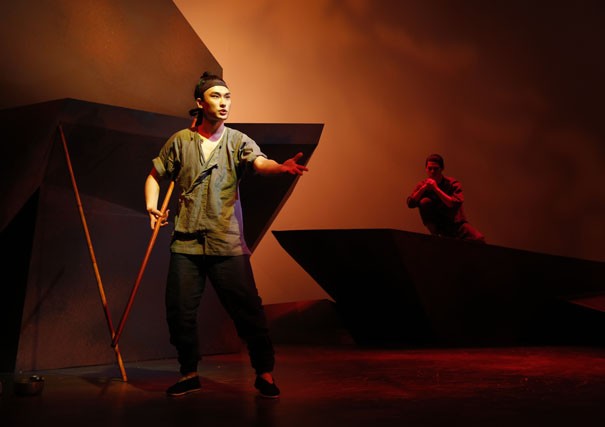
Ma (Ruy Iskandar) and Lone (Yuekun Wu) discuss immigration, unions, life, and opera in THE DANCE AND THE RAILROAD (photo by Joan Marcus)
The Pershing Square Signature Center
The Alice Griffin Jewel Box Theatre
480 West 42nd St. between Tenth & Eleventh Aves.
Through March 24, $75
212-244-7529
www.signaturetheatre.org
David Henry Hwang’s Residency One season at the Signature continues with an engaging revival of his second work, the short historical one-act The Dance and the Railroad. Written specifically for actors John Lone and Tzi Ma in 1981, the play was originally performed for children at the New Federal Theatre, but a rave review by Frank Rich helped it move to the Public, where it ran for six months to a more adult audience. The seventy-minute piece is set in California in 1867, where transcontinental railroad employees Lone (Yuekun Wu) and Ma (Ruy Iskandar) are taking a break on a mountaintop during a bold workers strike. The older, more experienced Lone, a master of Chinese opera, is practicing his discipline, which intrigues Ma, who only recently came over from China and thinks he can quickly learn to play Gwan Gung, a heroic mythical figure from the epic novel Romance of the Three Kingdoms. But Ma will have to learn a whole lot more about life, not just opera, before being able to earn such a challenge and honor. Mimi Lien’s set consists of rocks that offer numerous platforms at different heights — evoking architect Frank Gehry’s design of the Alice Griffin Jewel Box Theater itself — allowing director May Adrales (In the House, Whaddabloodclot!!!) to have the actors on the same level or above or below each other, changing the dynamic of their evolving relationship. Jiyoun Chang’s lighting changes night to day with projections on the background, while Huang Ruo’s score emphasizes the Chinese folk music tradition. The dance movements were choreographed by Chinese opera consultant Qian Yi, the star of the famous twenty-hour 1999 Lincoln Center Festival production of The Peony Pavilion. Wu and Iskandar make an excellent team in the two-person show, the former appropriately sly and serious, the latter wide-eyed and innocent. Despite its being more than three decades old and about an event that took place nearly 150 years ago, The Dance and the Railroad holds up extremely well, given America’s current battles over immigration and unions. Hwang’s residency at the Signature, which began with the disappointing Golden Child, will conclude next year with the world premiere of Kung Fu, about a Hong Kong martial artist who comes to America in the 1960s to become a movie star.